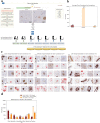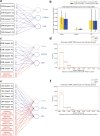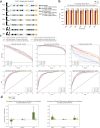Deep learning from multiple experts improves identification of amyloid neuropathologies
- PMID: 35484610
- PMCID: PMC9052651
- DOI: 10.1186/s40478-022-01365-0
Deep learning from multiple experts improves identification of amyloid neuropathologies
Abstract
Pathologists can label pathologies differently, making it challenging to yield consistent assessments in the absence of one ground truth. To address this problem, we present a deep learning (DL) approach that draws on a cohort of experts, weighs each contribution, and is robust to noisy labels. We collected 100,495 annotations on 20,099 candidate amyloid beta neuropathologies (cerebral amyloid angiopathy (CAA), and cored and diffuse plaques) from three institutions, independently annotated by five experts. DL methods trained on a consensus-of-two strategy yielded 12.6-26% improvements by area under the precision recall curve (AUPRC) when compared to those that learned individualized annotations. This strategy surpassed individual-expert models, even when unfairly assessed on benchmarks favoring them. Moreover, ensembling over individual models was robust to hidden random annotators. In blind prospective tests of 52,555 subsequent expert-annotated images, the models labeled pathologies like their human counterparts (consensus model AUPRC = 0.74 cored; 0.69 CAA). This study demonstrates a means to combine multiple ground truths into a common-ground DL model that yields consistent diagnoses informed by multiple and potentially variable expert opinions.
Keywords: Algorithms; Amyloid beta; Consensus; Deep learning; Expert annotators; Histopathology.
© 2022. The Author(s).
Conflict of interest statement
The authors declare that they have no competing interests.
Figures







Similar articles
-
On the objectivity, reliability, and validity of deep learning enabled bioimage analyses.Elife. 2020 Oct 19;9:e59780. doi: 10.7554/eLife.59780. Elife. 2020. PMID: 33074102 Free PMC article.
-
Learning fast and fine-grained detection of amyloid neuropathologies from coarse-grained expert labels.Commun Biol. 2023 Jun 24;6(1):668. doi: 10.1038/s42003-023-05031-6. Commun Biol. 2023. PMID: 37355729 Free PMC article.
-
Deep learning assisted quantitative assessment of histopathological markers of Alzheimer's disease and cerebral amyloid angiopathy.Acta Neuropathol Commun. 2021 Aug 21;9(1):141. doi: 10.1186/s40478-021-01235-1. Acta Neuropathol Commun. 2021. PMID: 34419154 Free PMC article.
-
Cerebral amyloid angiopathy: diagnosis and potential therapies.Expert Rev Neurother. 2018 Jun;18(6):503-513. doi: 10.1080/14737175.2018.1480938. Epub 2018 May 31. Expert Rev Neurother. 2018. PMID: 29792540 Review.
-
Mechanism of cerebral beta-amyloid angiopathy: murine and cellular models.Brain Pathol. 2006 Jan;16(1):40-54. doi: 10.1111/j.1750-3639.2006.tb00560.x. Brain Pathol. 2006. PMID: 16612981 Free PMC article. Review.
Cited by
-
Artificial intelligence-derived neurofibrillary tangle burden is associated with antemortem cognitive impairment.Acta Neuropathol Commun. 2022 Oct 31;10(1):157. doi: 10.1186/s40478-022-01457-x. Acta Neuropathol Commun. 2022. PMID: 36316708 Free PMC article.
-
Development of a sperm morphology assessment standardization training tool.Biol Methods Protoc. 2025 Apr 12;10(1):bpaf029. doi: 10.1093/biomethods/bpaf029. eCollection 2025. Biol Methods Protoc. 2025. PMID: 40297549 Free PMC article.
-
Toward a generalizable machine learning workflow for neurodegenerative disease staging with focus on neurofibrillary tangles.Acta Neuropathol Commun. 2023 Dec 18;11(1):202. doi: 10.1186/s40478-023-01691-x. Acta Neuropathol Commun. 2023. PMID: 38110981 Free PMC article.
-
Learning precise segmentation of neurofibrillary tangles from rapid manual point annotations.bioRxiv [Preprint]. 2024 Sep 24:2024.05.15.594372. doi: 10.1101/2024.05.15.594372. bioRxiv. 2024. PMID: 39386601 Free PMC article. Preprint.
-
The status of digital pathology and associated infrastructure within Alzheimer's Disease Centers.J Neuropathol Exp Neurol. 2023 Feb 21;82(3):202-211. doi: 10.1093/jnen/nlac127. J Neuropathol Exp Neurol. 2023. PMID: 36692179 Free PMC article.
References
-
- Campanella G, Hanna MG, Geneslaw L, Miraflor A, Werneck Krauss Silva V, Busam KJ, Brogi E, Reuter VE, Klimstra DS, Fuchs TJ. Clinical-grade computational pathology using weakly supervised deep learning on whole slide images. Nat Med. 2019;25:1301–1309. doi: 10.1038/s41591-019-0508-1. - DOI - PMC - PubMed
-
- Fillenbaum GG, van Belle G, Morris JC, Mohs RC, Mirra SS, Davis PC, Tariot PN, Silverman JM, Clark CM, Welsh-Bohmer KA, Heyman A. Consortium to Establish a Registry for Alzheimer’s Disease (CERAD): the first twenty years. Alzheimers Dement. 2008;4:96–109. doi: 10.1016/j.jalz.2007.08.005. - DOI - PMC - PubMed

